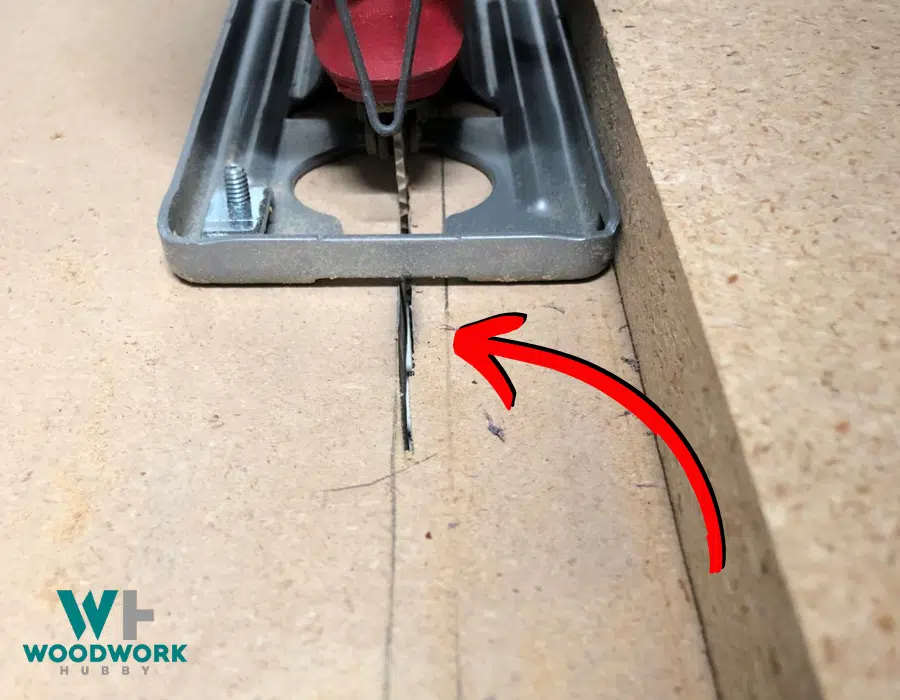I have been woodworking since the early 1990s, and I have used a jigsaw predominantly over that time. I used to cut out holes in bench tops for kitchen sinks and I know all too well why I jigsaw doesn’t cut straight. I decided to write down this information to help you out.
Your jigsaw doesn’t cut straight due to the following 8 reasons:
- Blade is Dull
- The wrong type of blade
- Pushing the jigsaw too hard
- Cutting too fast
- The Jigsaw base is not at 90 degrees
- Guide bearings are worn
- Don’t use a straightedge
- Wrong tool for the job
In this article, you will learn why your jigsaw doesn’t cut straight and how you can get it to do so. Among other things, I will explain the 8 possible reasons for crooked cuts and 8 solutions that correspond to each reason.
You will also learn how to keep a jigsaw blade vertical so that it doesn’t cut unwanted bevels. But first, let’s address the main causes of non-straight cuts.
Why Does My Jigsaw Cut Crooked?
Your jigsaw isn’t cutting straight because its blade is dull or the material it is trying to cut isn’t meant to be cut with a jigsaw. It is also possible that your cutting technique doesn’t leverage the blade strength and must be adjusted.
I see this type of post on social media all too often!
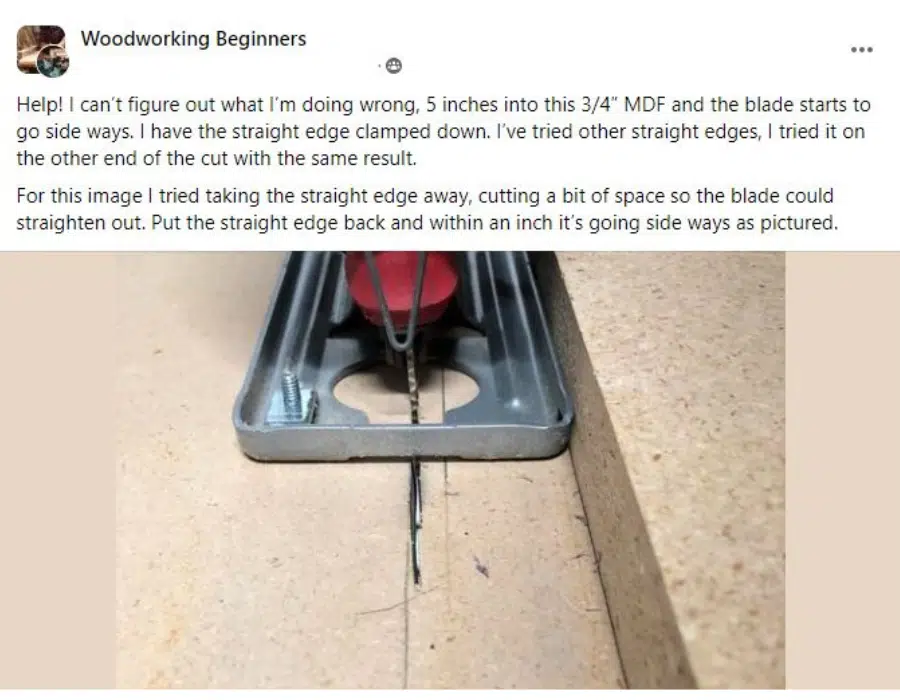
While there are 8 possible reasons for a jigsaw making crooked cuts, they fall into two broad categories: blade problems and sawing problems. Blade problems can be fixed by swapping blades or cutting tools.
Sawing problems are issues in your cutting technique and can be the quickest to fix since no new blade or sawing tool is needed. Let’s look at the eight specific reasons behind crooked cuts and how you can counter them.
I also wrote an article on why your jigsaw blade bends which would be an important read for you as well.
1. Blade Is Dull
In my experience, this is the culprit most of the time. The blade of a jigsaw can get dull just doing normal project work. Most woodworkers think that if they don’t use their saws to cut unusual materials, their sawblades should remain sharp.
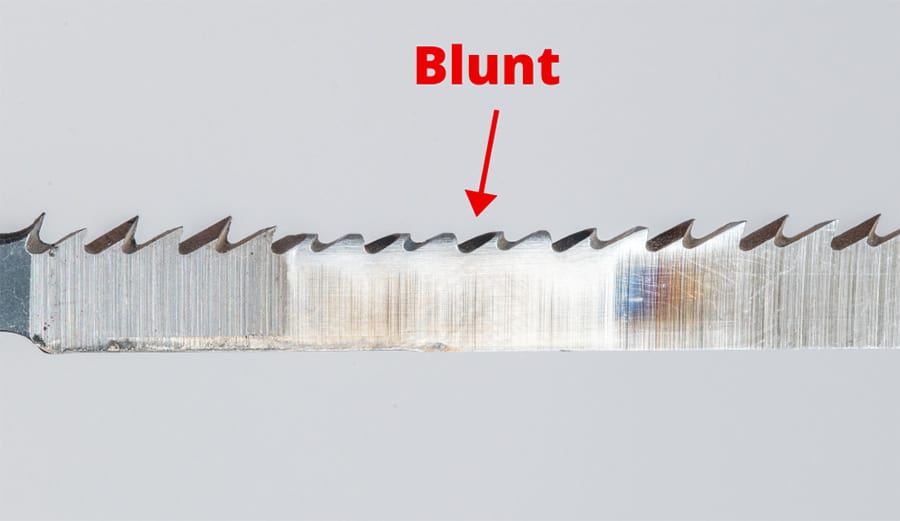
My Hot Tip: Always use a new sharp blade on important cuts!
They do remain sharp, but eventually, all blades become dull. This would be considered a saw problem. If your jigsaw used to cut the material you’re currently trying to cut but now produces jagged cuts, check the blade’s sharpness. Sharpening the blade or swapping a new one in can actually improve the straightness of the cuts.
2. The Wrong Type Of Blade
It is important to use the right type of jigsaw blade to suit the material you are cutting. Don’t skimp here!
For example – A fine-toothed blade should not be used to cut thick hardwood. Always try to match the blade type to the material you are cutting.
Here Are Some Blades I Recommend
3. Pushing The Jigsaw Too Hard
It might seem paradoxical, but if you push the jig saw too hard, it can produce a crooked cut. This is a sawing problem and not a blade issue. Excessive force can bypass the working principle of the jigsaw.
The blade has to first cut the wood and produce a crevasse, and then more force should drive the blade further in. But if you push too hard, the wood isn’t opened up, and instead, the blade angle ends up shifting under your force.
This can create a leaning cut at best and a crooked or jagged one at best. If this is the reason why your jigsaw is not cutting straight, then it must exist from the first time you use the jigsaw.
Pro Tip: Relax and let the jigsaw do the work!
4. Cutting Too Fast
Most people try to push the jigsaw through the material too fast which creates excessive heat on the blade. This heat in turn softens the blade and will make it bend much easier.
Fast cuts can also come from the reciprocating action you have the jigsaw set on. Most jigsaws have a switch on the side of the machine that sets how far out the blade will come forward on each cut called the oscillator switch.
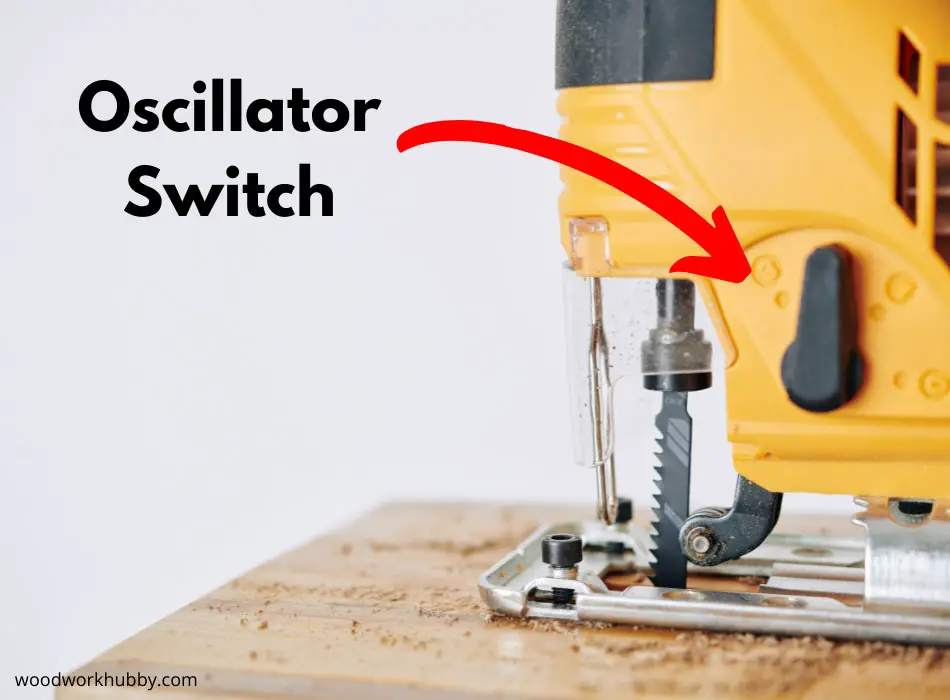
I have found that setting this at the maximum can cause the blade to cut aggressively and cause crooked cuts.
Try to find a happy medium with this switch depending on the material you are cutting.
5. The Jigsaw Base Isn’t At 90 degrees
Double-check your jigsaw base. A loose base produces jagged cuts, while a tilted base creates leaning cuts reminiscent of bevels. Usually, the base might come loose if you fail to secure it after adjusting it.
But there are also instances where the jigsaw becomes unstable after cutting through a particularly tough material. By adjusting the base and securing it, so it is square and flat, you ensure that the cuts it executes are also straight.
A wrote some other articles about jigsaws that may interest you.
My jigsaw blade keeps falling out
6. The Guide Bearings Are Worn
The guide bearings are the rollers that sit on either side of your blade and support the blade during a cut. Worn guides can be a major factor in a wandering blade. Typically these tend to be pretty bad on cheaper jigsaws.
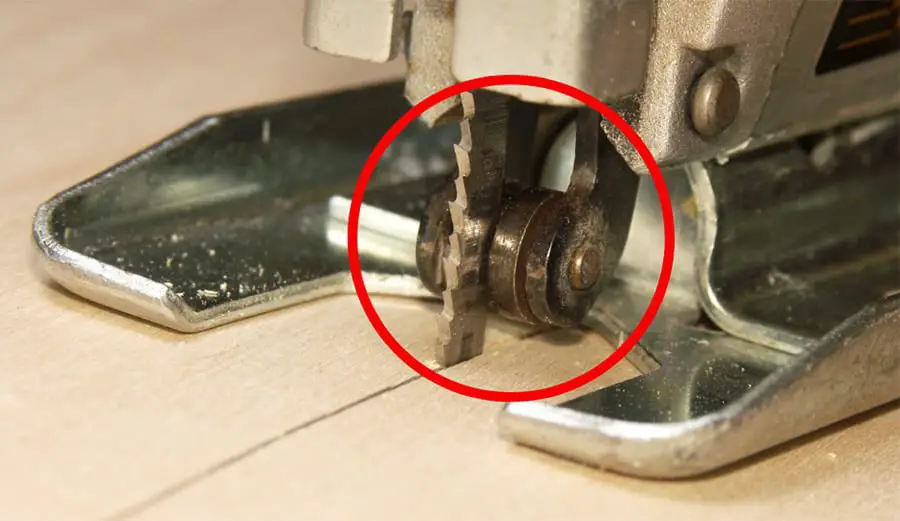
With your jigsaw unplugged, use your fingers to push the blade side to side. If there is more than 2mm of movement in the guide bearings, it might be time to replace them.
Pro Tip: Don’t skimp on your jigsaw. A good quality one will give much better results!
7. Don’t Use A Straightedge
This could be probably the biggest mistake beginners make when using a jigsaw and will lead me to point 8 below. A jigsaw is meant for cutting curves and while it can do some straight cuts, it’s not really meant for it.
Do me a favor, grab your jigsaw and draw a straight line, then try to follow that line with your jigsaw. While making the cut, take notice of the back of the jigsaw and your hand as you cut.
You will be making fine adjustments with the jigsaw left and right to keep the blade straight almost like you are steering it. This is why you SHOULD NOT use a straightedge.
The machine sitting hard against a straight edge doesn’t allow you to make these fine adjustments and in turn, causes a crooked cut!
8. The Wrong Tool For The Job
This is a simple truth! A jigsaw is simply not meant for straight cuts. If you want to make straight cuts then you should be using a Circular Saw or table saw.
While a jigsaw can handle some straight cuts, don’t rely on it to be perfect. It’s just the wrong tool.
My Biggest Tip: All tools are made for different purposes. Use them how they are intended and you will get great results!
How Do You Cut Straight With A Jigsaw?
To cut straight with a jigsaw, you need to steer the jigsaw side to side while cutting and avoid using a fence or straightedge.
The video below shows how you can execute this.
A video showing how to cut a straight line with a jigsaw.
As you can tell, this steadying method works only when the crooked sawing is the result of improper sawing technique. If the blade or the saw base is the problem, then this method will not work.
How Do You Fix A Jigsaw That Won’t Cut Straight?
To fix a jigsaw that won’t cut straight, you need to sharpen or replace its blade, adjust its base on a flat surface, and secure it before using it to cut a material it is meant to cut. Use a fence and a steadying hand to further make the cut more accurate.
Here’s how each of the steps affects the overall outcome:
- Swapping the blade – Don’t sharpen. Simply buy good quality blades!
- Securing the base – By fixing the base, you offset the possibility that the base’s instability is producing crookedness in the cuts.
- Use the right blade – Jigsaw blades come in many different varieties. Ensure you are using the correct one for its intended application.
- Using a steadying hand – The steadying hand keeps the blade from getting pushed too hard, preventing it from leaning the other way.
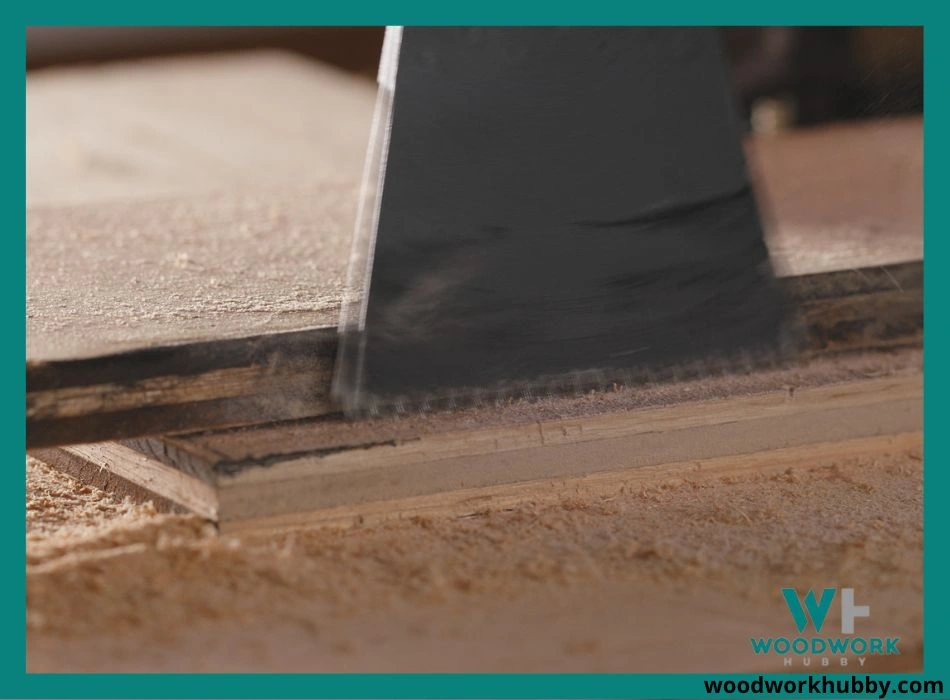
Why Can’t I Cut A Straight Line With My Jigsaw?
You cannot cut a straight line with your jigsaw because the straight path produces more resistance than sideways cutting. This happens when the blade is blunt, the base is at an angle, or there is no steadying force to keep the saw straight.
Try repeating your attempts to cut straight with a jigsaw. The pattern of errors will expose the true cause. Just like I mentioned in the beginning, my jigsaw’s problem was an old and weak blade. I found that out by making a few attempts and noticing the patterns.
Here are the potential patterns and what they reveal about the cause of non-straight cuts.
| Jigsaw cutting pattern | Cause | Explanation |
|---|---|---|
| Cuts unwanted bevels | The base is crooked | The base must be squared, or you need to adjust how you hold the saw |
| The cut moves the left side, but the saw stays vertical | Could be a blunt blade | Try a sharp blade. |
| The cut moves towards the right, blowing past the wood. The jigsaw stays vertical. | You are pushing too hard | Use your left hand to pull back the saw while the right hand pushes forward. |
The above table will take care of any consistent pattern of non-straight cuts. But what if there is no pattern? In that case, your problem is the same as mine.
If your jigsaw cuts in a non-straight manner, but the cuts are randomly crooked or appear shaken, then the problem is with the blade itself. Try cutting with the jigsaw after swapping it out with a sharper blade.
Why Are My Jigsaw Cuts At An Angle?
Your jigsaw cuts are at an angle if the base of the jigsaw isn’t secure or you’re driving the jigsaw too fast. When pushing too hard, the blade generally moves from left to right, following the dominant hand.
When the cut is straight but beveled, then the problem isn’t how hard you drive the jigsaw but is in how the saw is set up. To remove involuntary bevels when cutting with a jigsaw, you need to ensure that the blade is vertical.
How Do You Keep A Jigsaw Blade Vertical?
To keep a jigsaw blade vertical, you must hold the jigsaw straight. You should also double-check that the base of the saw isn’t at an angle. A loose or angle-set base can produce bevel cuts when you want straight ones.
Here are the steps you should take to make sure your jigsaw cuts vertically straight:
- Use a sharp blade – This is a best practice for any type of cut. A sharp blade reduces the burden of force. And as covered earlier, excessive force can produce crooked results.
- Adjust the base to be flat – You can place the base on a flat wood surface and see that it makes full contact. If any part of the base is off the flat surface, then it is set at an angle.
- Hold the jigsaw so the base is parallel to the surface – After placing the base on a flat surface like a workbench or a tabletop, secure the base. As long as the jigsaw base is flat when it is secured, the only thing you have to do after that holds the jigsaw straight.
- Cut slowly and steadily – Cut slowly, so you don’t end up moving the jigsaw at an angle if the wood block puts up resistance. The slower you are, the more thoughtful you can be about the straightness of the jigsaw.
Why Does My Jigsaw Cut Skew?
Your jigsaw cut skews because there is no fence guiding it or the base of the jigsaw is skewed. If you push too quickly, the cut can skew toward the path of least resistance.
The reasons behind a skewed cut are different from those behind jagged cuts. Jagged cuts occur when the blade is too dull, or the jigsaw is being used to cut something it is not meant to cut.
Can I Cut Metal With A Jigsaw?
One of the things that a jigsaw blade should not be used to cut is a metal block. While jigsaw blades can cut sheet metal and metallic veneer, they shouldn’t cut thick metal boards. Any attempt at doing so can dull the blade and produce irregular cuts.
Metals can range from soft alloys to hard solids. So before you cut even a sheet with a jigsaw, check if the specific metal should be cut with a jigsaw blade. Iron, for instance, should never be cut with a jigsaw, but an aluminum sheet can be cut with it.
Can A Jigsaw Be Adjusted To Cut At Different Angles?
Most jigsaws can cut at slight angles, but not all jigsaws come with adjustable bases. If your jigsaw has an adjustable base, it can cut at different angles.
Make sure to readjust the base after making bevel cuts. If you don’t restore the jigsaw base to its flat position, the next person using the jigsaw might wonder why his cuts are not straight. And trust me, that person could be you.
Final Thoughts
If your jigsaw isn’t cutting straight, there’s no need to worry. It is common and can happen because of multiple reasons. These range from pushing too hard to having a poorly adjusted jigsaw base.
Usually, if you fix the base and have a fence to guide the cut, the cuts will come out pretty straight. Don’t forget to use your non-dominant hand to reign in the jigsaw as you drive it forward. That keeps the blade from being pushed harder than it wants to go.

